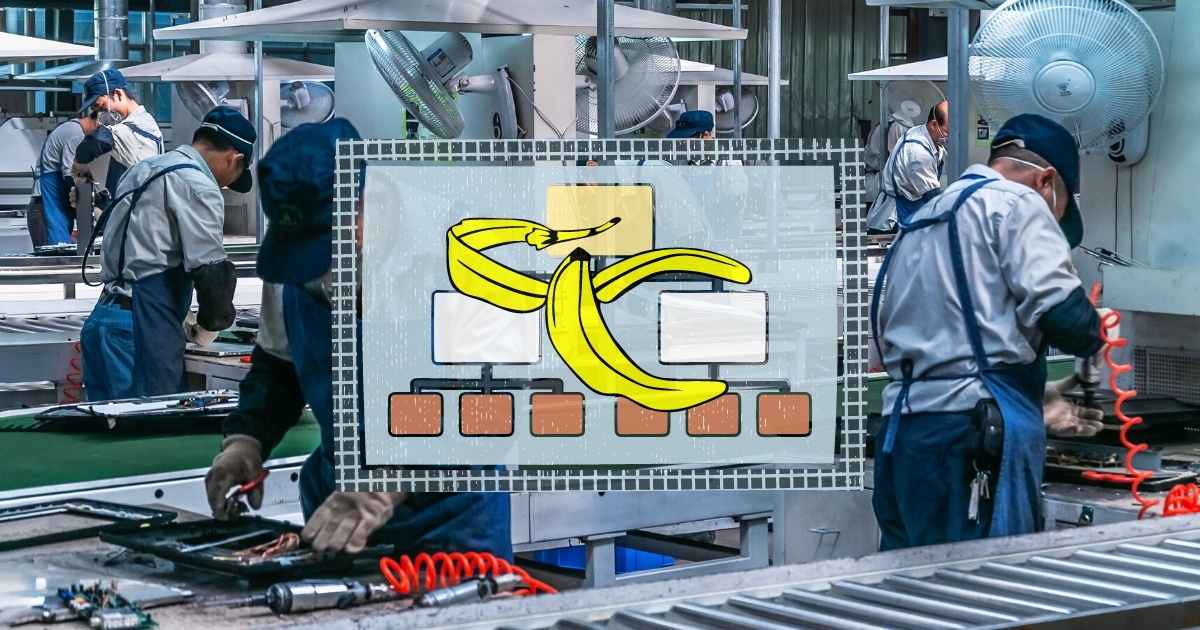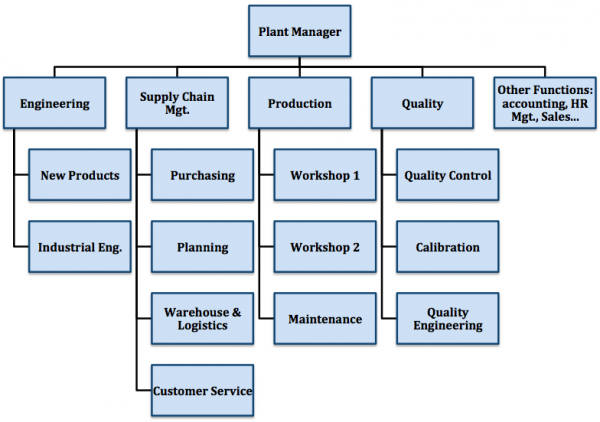
One of the first things we look at, during factory audits, is the supplier’s manufacturing organizational chart. And it often points to serious operational dysfunctions. Here are the top 7 common mistakes that you don’t want to see your supplier making…
The ISO 9001 standard does not require a factory org chart to be prepared (it only asks for the definition and communication of authority lines). It is a very common document, though, and many Chinese manufacturers fall into the same pitfalls that could result in a negative result for you.
Here are the top 7 mistakes suppliers make that can be uncovered from their manufacturing organizational chart:
Mistake 1: not having a quality department
Most small workshops don’t have personnel dedicated to checking quality on a full-time basis. The problem is, very often nobody checks quality at all! That’s a serious problem and only buyers who can station inspectors on-site 24/7 should do business with such suppliers.
Mistake 2: placing the quality department under the production manager
The production department’s focus is naturally to get products out of the door quickly while keeping costs down (Note: this is true in at least 95% of manufacturing organizations, with the exceptions of the most mature companies. It is not the case in a good Toyota plant, for example, since incentives push production leaders to take responsibility for quality and they have the training necessary.).
So there needs to be someone with authority to say “stop” when quality requirements are not met.
If that someone (the quality manager or one of his subordinates) reports to the production manager, there is an obvious lack of independence.
Mistake 3: placing the planning department under the production manager
In most well-managed factories, the production department is evaluated on the efficiency of each of its workshops. The efficiency rate is the planned theoretical time divided by the actual production time.
If the planned time for completion is set very low, efficiencies will be artificially high and the production manager won’t have to push his team too hard.
Who sets the planned time? Often, the planning team (based on the “standard” time for each part, which is typically provided by the product development and/or industrial engineering teams, but that’s not always the case). Therefore the planning manager should not report to the production manager. In fact, the planning team is usually in the supply chain management organization (closely related to purchasing and logistics), rather than production.
Mistake 4: not placing maintenance under the production manager
I see two reasons why maintenance should be managed by the production manager:
- The production department should be responsible for the good upkeep of machines. One of the basic principles of TPM (Total Productive Maintenance) is that each operator should tend to the equipment she works on. Don’t delegate that to a support function in another department!
- Downtime/stoppages interrupt the flow, which means efficiencies are lower. It is much better when the production manager, instead of blaming another department (and having a convenient excuse), looks inward and tries to improve the processes he controls.
However, as is often the way, not placing maintenance under the production manager is not always a mistake. In relatively large structures, a solid “service level agreement” might be in place. Production is an internal customer of maintenance. The maintenance teams are organized in one department, which favors the acquisition and development of skills.
Mistake 5: not having an IE department
I see many factories in China that employ more than 500 workers but don’t have an IE (Industrial Engineering) department (some companies would call it process engineering and others manufacturing engineering). But, in the long run, a good IE department saves a factory a lot of money.
Such a department focuses on making the work easier, safer, and of higher quality (among other things). To that end, it designs jigs and other tools, improves the layout and the flow, reconfigures the equipment, and so on.
Mistake 6: burying the HR manager 2 or 3 levels below top management
I don’t know any company operating for whom human resources management is not strategic. A good HR manager improves the average skill level, reduces turnover, prevents most accidents and suicides, and helps create a strong culture. HR also helps ensure compliance, and that’s critical, as manufacturing organizations need to pay attention to all sorts of safety hazards and operate in a legal environment that has generated all sorts of rules. This function is at least as important as finance, general admin, or legal.
Mistake 7: giving very unclear titles
In China, inflated titles are very common. Here are a few examples of misleading titles:
- Several “general managers” on the same factory org chart.
- An “operations manager” and a “production manager” on the same hierarchical level.
- A GM assistant with the title “fu zhong” (vice-GM) in Chinese.
An example of a sound org chart
Criticizing Chinese companies can make for good reading, but I guess there is value in being useful too. Here is how I would design an ideal factory’s manufacturing organizational chart (I had no space to represent functions such as HR, sales, etc., as I wanted to focus first on the management of development & operations).
To clarify: this example is usually a good fit for factories employing between 80 and 400 people and doing typical “mass production” work. It always needs to be reviewed for relevance to the needs and constraints of the organization.
What are your thoughts?
Does your supplier have a manufacturing organizational chart like this, or are they guilty of some of the mistakes mentioned? Let me know by commenting.
Editor’s note: This post was originally published in May 2014 and has been updated with new content in August 2022.
Ultimate Guide To Sourcing From China And Developing Your Suppliers [eBook]
This FREE eBook starts from the beginning, discussing whether you need to hire a sourcing agent, and follows the sourcing process right through to developing a trusted supplier’s quality and productivity.
There are 15 chapters over 80+ pages to explore, providing exhaustive guidance on the entire sourcing and supplier development process from start to finish, including:
- Identifying suppliers,
- Negotiations,
- Quality inspections,
- Developing Chinese suppliers,
- Improving factory quality and productivity,
- and much more…



